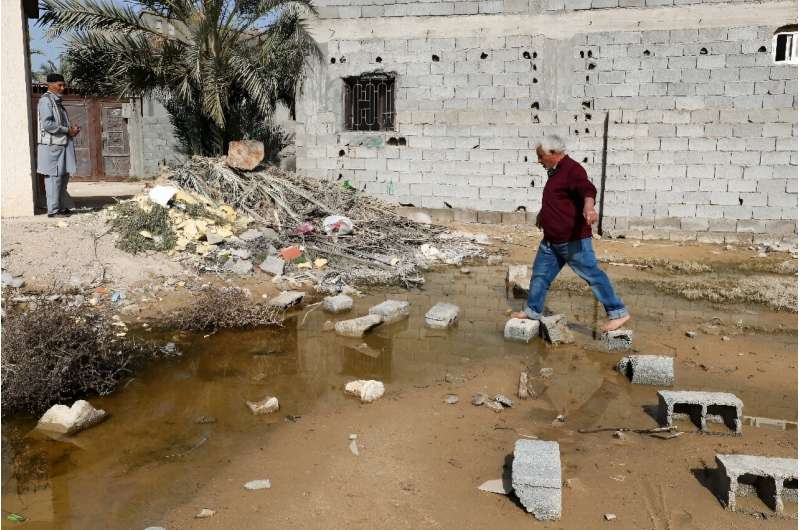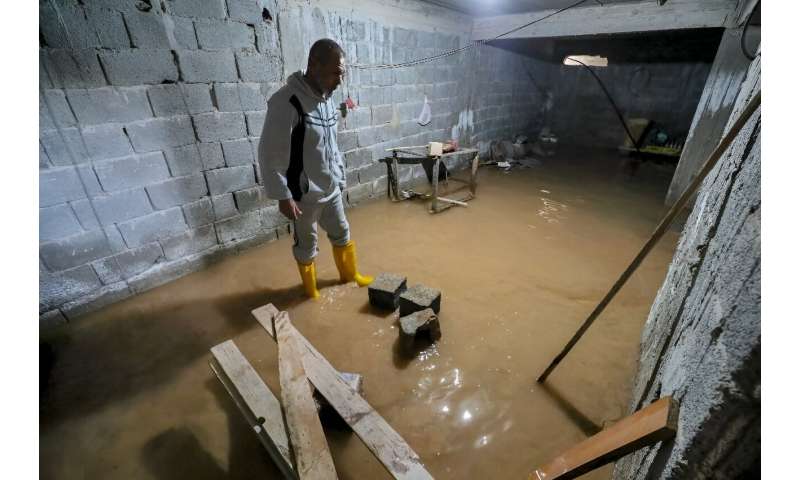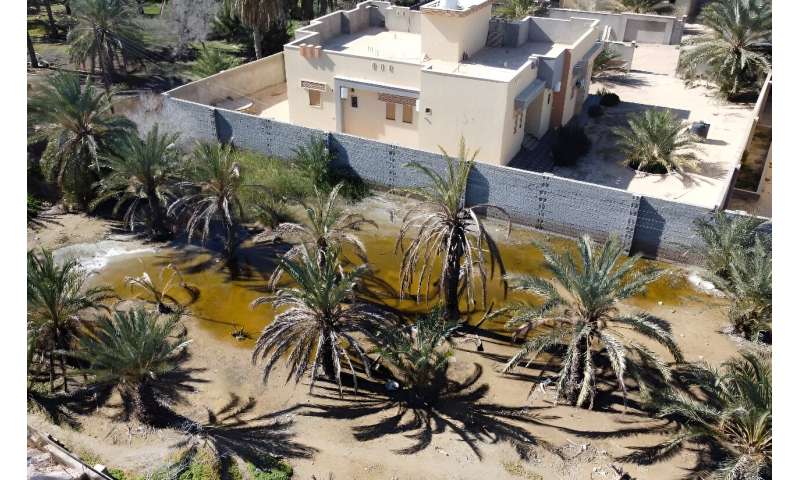Much of Libya is bone-dry desert but one Mediterranean coastal town is suffering the opposite problem—its houses and fields have been inundated by a mysterious upsurge of groundwater.
Stagnant water and squishy mud have flooded houses, streets and palm groves around the northwestern town of Zliten, spreading a foul smell and creating breeding grounds for mosquitos.
Many locals have fled their homes, where walls have cracked or collapsed, amid fears of a worsening environmental crisis in the area about 160 kilometers (100 miles) east of the capital Tripoli.
“Water began coming out two months ago and still continues to rise and submerge our wells,” Mohamad Ali Dioub, owner of a farm some four kilometers from Zliten, told AFP. “All my fruit trees—apple, apricot and pomegranate trees—are dead.”
The 60-year-old said he had rented water trucks to pump out the stagnant water and bought loads of sand to dump onto the soggy ground, in an effort to save some of his valuable date palms.
The area’s usually sandy and light earth has become “muddy, black, and smells bad,” said another farmer, Mohamad al-Nouari, whose land has been completely swamped.
Almost 50 families have been relocated, said Moftah Hamadi, the mayor of Zliten, a town of 350,000 people known for its Sufi shrines, al-Asmariya University and palm and olive groves.

Prime Minister Abdelhamid Dbeibah vowed this month to “remediate this crisis in a scientific and rapid manner” and urged authorities to compensate or relocate displaced families.
But there is no consensus yet on what has caused the flooding.
Stench and mosquitos
Libya has been plagued by conflict and turmoil since the fall of Moamer Kadhafi’s regime in 2011 and is now governed by two rival administrations, based in Tripoli and Benghazi.
Catastrophic floods ravaged Libya’s eastern city of Derna in September when two dams collapsed. The gigantic flood surge killed more than 4,300 people and left over 8,000 missing, according to the UN.
Locals in Zliten say the groundwater flooding is not new, and point to reed-covered areas from years-old inundations. But they also say the phenomenon has now hit them on a previously unknown scale.
-

A man stands in the flooded basement of a home.
-

Water-logged earth near a home in Libya’s coastal city of Zliten.
Media reports have pointed to a variety of possible causes, from poor drainage infrastructure to damaged pipelines and heavy winter rains.
Foreign specialists, including from Britain, Egypt and Greece, have traveled to Zliten, hoping to identify the origin of the problem and find solutions.
Elsewhere in the world, rising sea levels have been linked to coastal groundwater upsurges as dense salt water can seep deep into the ground and push up the lighter freshwater.
Libyan authorities have meanwhile denied any link between the flooding and the so-called Great Man-Made River, a giant Kadhafi-era network of pipes that channels water from an aquifer deep below the southern desert to irrigate coastal farms areas.
The project’s management company as well as the country’s main water and power utilities have all joined efforts to alleviate the town’s ordeal.
And the country’s national center for disease control has dispatched emergency teams, equipment and pesticide to eradicate the mosquito swarms.
© 2024 AFP
Citation:
Groundwater upsurge floods homes in Libyan coastal town (2024, February 15)
retrieved 15 February 2024
from https://phys.org/news/2024-02-groundwater-upsurge-homes-libyan-coastal.html
This document is subject to copyright. Apart from any fair dealing for the purpose of private study or research, no
part may be reproduced without the written permission. The content is provided for information purposes only.

